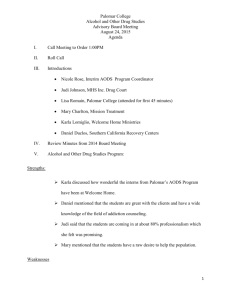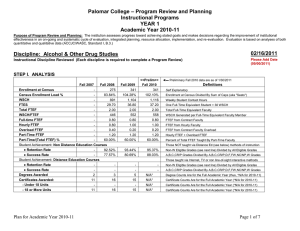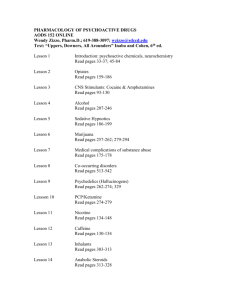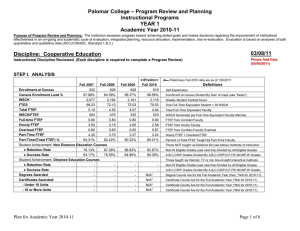Alcohol and Other Drugs
advertisement
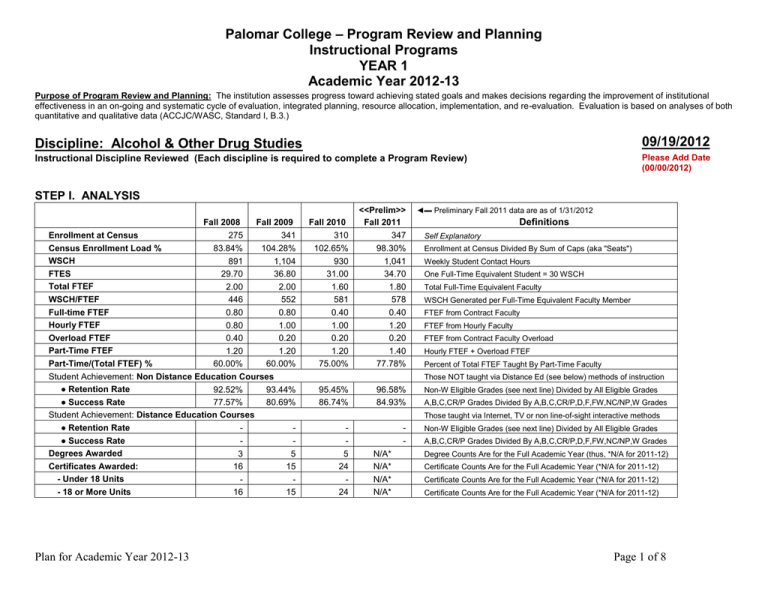
Palomar College – Program Review and Planning Instructional Programs YEAR 1 Academic Year 2012-13 Purpose of Program Review and Planning: The institution assesses progress toward achieving stated goals and makes decisions regarding the improvement of institutional effectiveness in an on-going and systematic cycle of evaluation, integrated planning, resource allocation, implementation, and re-evaluation. Evaluation is based on analyses of both quantitative and qualitative data (ACCJC/WASC, Standard I, B.3.) Discipline: Alcohol & Other Drug Studies 09/19/2012 Instructional Discipline Reviewed (Each discipline is required to complete a Program Review) Please Add Date (00/00/2012) STEP I. ANALYSIS Fall 2008 Fall 2009 Enrollment at Census 275 341 Census Enrollment Load % 83.84% 104.28% WSCH 891 1,104 FTES 29.70 36.80 Total FTEF 2.00 2.00 WSCH/FTEF 446 552 Full-time FTEF 0.80 0.80 Hourly FTEF 0.80 1.00 Overload FTEF 0.40 0.20 Part-Time FTEF 1.20 1.20 Part-Time/(Total FTEF) % 60.00% 60.00% Student Achievement: Non Distance Education Courses ● Retention Rate 92.52% 93.44% ● Success Rate 77.57% 80.69% Student Achievement: Distance Education Courses ● Retention Rate ● Success Rate Degrees Awarded 3 5 Certificates Awarded: 16 15 - Under 18 Units - 18 or More Units 16 15 Plan for Academic Year 2012-13 Fall 2010 310 102.65% 930 31.00 1.60 581 0.40 1.00 0.20 1.20 75.00% <<Prelim>> Fall 2011 347 98.30% 1,041 34.70 1.80 578 0.40 1.20 0.20 1.40 77.78% ◄▬ Preliminary Fall 2011 data are as of 1/31/2012 Definitions Self Explanatory Enrollment at Census Divided By Sum of Caps (aka "Seats") Weekly Student Contact Hours One Full-Time Equivalent Student = 30 WSCH Total Full-Time Equivalent Faculty WSCH Generated per Full-Time Equivalent Faculty Member FTEF from Contract Faculty FTEF from Hourly Faculty FTEF from Contract Faculty Overload Hourly FTEF + Overload FTEF Percent of Total FTEF Taught By Part-Time Faculty Those NOT taught via Distance Ed (see below) methods of instruction 95.45% 86.74% 96.58% 84.93% Non-W Eligible Grades (see next line) Divided by All Eligible Grades A,B,C,CR/P Grades Divided By A,B,C,CR/P,D,F,FW,NC/NP,W Grades Those taught via Internet, TV or non line-of-sight interactive methods 5 24 24 N/A* N/A* N/A* N/A* Non-W Eligible Grades (see next line) Divided by All Eligible Grades A,B,C,CR/P Grades Divided By A,B,C,CR/P,D,F,FW,NC/NP,W Grades Degree Counts Are for the Full Academic Year (thus, *N/A for 2011-12) Certificate Counts Are for the Full Academic Year (*N/A for 2011-12) Certificate Counts Are for the Full Academic Year (*N/A for 2011-12) Certificate Counts Are for the Full Academic Year (*N/A for 2011-12) Page 1 of 8 I. A. Reflect upon and provide an analysis of the four years of data above (for a sample analysis see http://www.palomar.edu/irp/11PRYear1/sampleforIA.pdf) AODS class enrollments continue to exceed maximum class sizes. In Fall 2012, the enrollment in our lecture classes is 34-49 and internship classes 24-28. The WSCH and total FTEF counts for AODS classes have grown over the last 4 years. AODS aggregate success rate improved significantly between Fall '09 and Fall '10 when the AODS Student Mentor program was initiated (Office of Research and Planning Mentor Study).The AODS Success Rate increased by 7.3% (from 80.7% to 88.0%) The difference is "statistically" significant (Chi-Square p<.05). The AODS aggregate success rate has been maintained at 85% between Fall 2010-Fall 2011. I. B. Please summarize the findings of Course AND Program SLO assessments conducted by your discipline. (For examples, see http://www.palomar.edu/irp/11PRYear1/PRPsloExamples.pdf) I.B.1 Summarize Course SLO assessment results beginning on the next line. Course SLO: Identification of psychoactive drugs by chemical, brand, and “street” names in the appropriate categories of: stimulant, depressant, psychedelic, or inhalant drugs. Correct Responses/Results: Pre-test: 30.3% Post-Test: 88.9% Stimulants: 88.9% Depressants: 83.1% Psychedelics and Inhalants: 94.6% I.B.2 Summarize Program SLO assessment results beginning on the next line. One of the program SLO's for AODS is for students to successfully pass the ICRC- AOD Counselor certification exam. In 2011, 100 % of the 11 Palomar College AODS students who took the exam passed. I. C. Reflect upon the SLO assessment findings in Box B above. Discuss overall observations and any areas of concern or noteworthy trends. (For examples of such analysis, see http://www.palomar.edu/irp/11PRYear1/PRPsloExamples.pdf) I.C.1 Please reflect upon the Course SLO findings in Box B (above) beginning on the next line. The weakest category on post-testing was the depressants, mainly opioids, which consists of a large variety of types. The average improvement, however, doubled from pre - testing. Memorization of the names included in this diverse category is challenging. As a result of these findings, identification of the “street” names were dropped from the evaluation process. Street names for psychoactive substances change on a regular basis and vary from region to region. Students are still required to identify drug and trade names. I.C.2 And, please reflect upon the Program SLO findings in Box B beginning on the next line. Students who complete the AODS program are well prepared for the certification exam. In the capstone course, AODS/PSYC/SOC 299 the course focuses on all the key knowledge areas covered on the exam, specifically the eight performance domains of an AOD counselor. Students complete extensive writing assignments and weekly practice multiple choice quizzes. The midterm exam is a 50 item multiple choice exam that utilizes test questions from ICRC test bank. By evaluating their midterm exam students are able to identify areas where they may need additional preparation for the certification exam. Plan for Academic Year 2012-13 Page 2 of 8 I. D. For Career Technical disciplines only, please provide a brief summary of the labor market outlook. This data can be found at http://www.labormarketinfo.edd.ca.gov/ Please include job projections and trends that may influence major curriculum revisions. Substance abuse counseling is one of the fastest growing professions in the US, projected to grow 20 percent by 2016.The employment projections for Substance Abuse Counselor in San Diego county is projected (2008-2018) to increase 13.8%. The hourly mean wage is $16.94. One factor that will impact substance abuse counseling is the Health Care Reform legislation which will impact the field in 2014. STEP II. PLANNING Reflecting on the 4-year trend data, the SLO assessment results, and the college’s Strategic Plan 2013, describe/discuss the discipline planning related to the following: (For sample reflections, see http://www.palomar.edu/irp/11PRYear1/samplesforII.pdf) II. A. Curriculum, programs, certificates and degrees (consider changes due to Title 5 or other regulations, CSU/UC transfer language updates, articulation updates, student retention or success rates, workforce and labor market projections, certificate or degree completions, etc.) The AODS curriculum is directed by the CAADE (CA Assn of Alcohol and Drug Educators) accreditation standards. Accreditation standards are in a state of revision due to changes in health care reform. At this time, no specific changes in curriculum are necessary. In the future, the AODS program should be linked at a CSU transfer program, as a bachelor's degree may be the minimum educational requirement for being certified as an AOD counselor. II. B. Class scheduling (consider enrollment trends, growth, course rotation, sequencing, Center/Site offerings, comprehensiveness, etc.) AODS course offerings fill quickly with full enrollments. Some of our program courses are only offered once a year (AODS 255, 160 and 298 and 299). Due to the high demand of these classes for program students to complete their requirements, we recommend that AODS 255 and 160 be offered every semester. The enrollment in AODS 255 in the Fall 2011 (52) and 2012 (49) and in the Spring 2012, AODS 160 had 55 students enrolled. The lab courses AODS 298 and 299 while high in enrollment do not need to be offered more than once a year at this time. The AODS program has offered one class per semester at the Escondido Center and it is recommended that this be continued. II. C. Faculty (Briefly discuss the faculty hiring needs for this discipline. This discussion does not replace the requirement to submit a Rationale Form for Faculty Hiring to IPC.) The current AODS program coordinator is retiring in May 2013 and the position should be replaced with a full-time faculty with 40% release time. The program accreditation through CAADE requires that the AODS program has a full time faculty coordinator. The position oversees eight parttime faculty and six student mentors and over 347 students in the program. The workload of the program coordinator has increased in the past three years to include six informational sessions each year to introduce students to program and career opportunities, bi annual AODS faculty meetings to develop SLO's and review progress, weekly student mentor training sessions, database collection of program students, site visits to all internship placement sites each semester, AODS Advisory Board meetings, and exam preparation workshops and review sessions for students taking their certification exam. Plan for Academic Year 2012-13 Page 3 of 8 STEP III. RESOURCE REQUESTS FOR DISCIPLINE: III. A. Describe the resources necessary to successfully implement the planning described above. Provide a detailed rationale for each request by referring to the analyses of data and SLO assessment results in Step I and/or to any other evidence not apparent in the data or SLO Assessment results. NOTE: Do NOT include Resource Requests that duplicate requests from other disciplines In your department. Place requests common to two or more disciplines on the form: ACADEMIC DEPARTMENT RESOURCE REQUESTS. a. Equipment (per unit cost is >$500) Enter requests on lines below. Resource Describe Resource Requested Prioritize these requests 1,2,3, etc. Strategic Plan 2013 Goal/ Objective Addressed by This Resource (Link) Provide a detailed rationale for the requested resource. The rationale should refer to your discipline’s plan, analysis of data, SLO assessments, and/or the College’s Strategic Plan Estimated Amount of Funding Requested Will this be one-time or on-going funding? Is resource already funded (in part or in full)? If so, name source. Why is that source not sufficient for future funding? Estimated Amount of Funding Requested Will this be one-time or on-going funding? Is resource already funded (in part or in full)? If so, name source. Why is that source not sufficient for future funding? a1. a2. a3. a4. a5. b. Technology (computers, data projectors, document readers, etc.) Enter requests on lines below. Resource Describe Resource Requested Prioritize these requests 1,2,3, etc. Strategic Plan 2013 Goal/ Objective Addressed by This Resource (Link) Provide a detailed rationale for the requested resource. The rationale should refer to your discipline’s plan, analysis of data, SLO assessments, and/or the College’s Strategic Plan b1. b2. b3. b4. b5. c. Budget for 4000s (per unit cost is <$500 supplies) Enter requests on lines below. Plan for Academic Year 2012-13 Page 4 of 8 Resource Describe Resource Requested Prioritize these requests 1,2,3, etc. Strategic Plan 2013 Goal/ Objective Addressed by This Resource (Link) Provide a detailed rationale for the requested resource. The rationale should refer to your discipline’s plan, analysis of data, SLO assessments, and/or the College’s Strategic Plan Estimated Amount of Funding Requested Will this be one-time or on-going funding? Is resource already funded (in part or in full)? If so, name source. Why is that source not sufficient for future funding? Will this be one-time or on-going funding? Is resource already funded (in part or in full)? If so, name source. Why is that source not sufficient for future funding? c1. c2. c3. c4 c5. d. Budget for 5000s (printing, maintenance agreements, software license etc.) Enter requests on lines below. Resource Describe Resource Requested Prioritize these requests 1,2,3, etc. Strategic Plan 2013 Goal/ Objective Addressed by This Resource (Link) Provide a detailed rationale for the requested resource. The rationale should refer to your discipline’s plan, analysis of data, SLO assessments, and/or the College’s Strategic Plan Estimated Amount of Funding Requested d1. d2. d3. d4. d5. e. Classified staff position (permanent/contract position requests unique to this discipline) Enter requests on lines below. Resource Describe Resource Requested Prioritize these requests 1,2,3, etc. Strategic Plan 2013 Goal/ Objective Addressed by This Resource (Link) Provide a detailed rationale for the requested resource. The rationale should refer to your discipline’s plan, analysis of data, SLO assessments, and/or the College’s Strategic Plan Estimated Amount of Funding Requested Will this be one-time or on-going funding? Is resource already funded (in part or in full)? If so, name source. Why is that source not sufficient for future funding? e1. e2. e3. e4. e5. Plan for Academic Year 2012-13 Page 5 of 8 f. Classified staff position (temporary and student workers position requests unique to this discipline) Enter requests on lines below. Resource f1. Describe Resource Requested Temporary Workers (AODS Mentors) Prioritize these requests 1,2,3, etc. 1 Strategic Plan 2013 Goal/ Objective Addressed by This Resource (Link) Goal 2: Strengthen programs and services in order to support our students’ educational goals. Provide a detailed rationale for the requested resource. The rationale should refer to your discipline’s plan, analysis of data, SLO assessments, and/or the College’s Strategic Plan One of the AODS program SLO's is to provide mentoring, support and early alert service to students enrolled in field placement and foundation AODS courses. A substantial number of students enter the AODS program struggling with poor academic skills and economic barriers such as not owning a computer. Over 70% of the AODS students report that they are in recovery from alcohol or other drug addiction. About 20% of AODS students report being on medication for psychiatric disorders (Ex. bipolar and major depression). Estimated Amount of Funding Requested $7,000 Will this be one-time or on-going funding? Ongoing Is resource already funded (in part or in full)? If so, name source. Why is that source not sufficient for future funding? Perkins Career and Technical Education Act funds the need at this time, but the funding is not permitted to meet a district need on a permanent basis. AODS students need special support and mentoring to persist in college, gain college success skills, maintain their personal recovery program, and become ready for employment. AODS aggregate success rate improved significantly between Fall '09 and Fall '10 when the AODS Student Mentor program was initiated. The success rate between Fall 2010 and Fall 2011 has maintained at 85%. f2. f3. f4. f5. III. B. Are there other resources (including data) that you need to complete your discipline review and planning? The AODS program has made research requests to the Research and Planning Office to supply data regarding our retention and success rates. Plan for Academic Year 2012-13 Page 6 of 8 STEP IV. SHARE YOUR ACCOMPLISHMENTS (AKA Brag, Toot your horn) Please include at least one discipline accomplishment that you’d like to share with the college community. There were 29 AODS students who completed AODS certificate program in May 2012. In a three month follow up, 60% (17) of the students were employed in the field of AOD treatment or Social Services, 20 % (6) were continuing their education, including graduate study, and 20% (6) were seeking AOD employment, either unemployed or working in a non related field. Student Mentor Program: Over the past four semesters, 12 student mentors were hired to assist students to persist in college, gain college success skills, maintain their personal recovery program, and in some cases, become ready for employment. During Fall 2010, mentors provided support and early alert service to students enrolled in all AODS courses. The pass rate for students taking their certifying exam CAADAC (California Association of Alcoholism and Drug Abuse Counselors) was 95% in 2008 with 11 students taking the exam and 100% in 2009 with 12 students. The number of students completing an AA/Certificate has steadily increased 13 (2008) 20 (2009). STEP V. ACCREDITATION For programs with an external accreditation, indicate the date of the last accreditation visit and discuss recommendations and progress made on the recommendations. The Palomar College AODS program completed a self study and reaccreditation was granted in April 2012 by the California Association of Alcohol and Drug Educators. STEP VI. COMMENTS Other comments, recommendations: (Please use this space for additional comments or recommendations that don’t fit in any category above.) Please identify faculty and staff who participated in the development of the plan for this department: Maria Miller Name Name Name Name Name Name Department Chair/Designee Signature Plan for Academic Year 2012-13 Date Page 7 of 8 Division Dean Signature Date Provide a hard copy to the Division Dean no later than September 14, 2012 Provide a hard copy with the Dean’s sign-off to Instructional Services by September 28, 2012 Email an electronic copy to jdecker@palomar.edu by September 28, 2012 Plan for Academic Year 2012-13 Page 8 of 8
